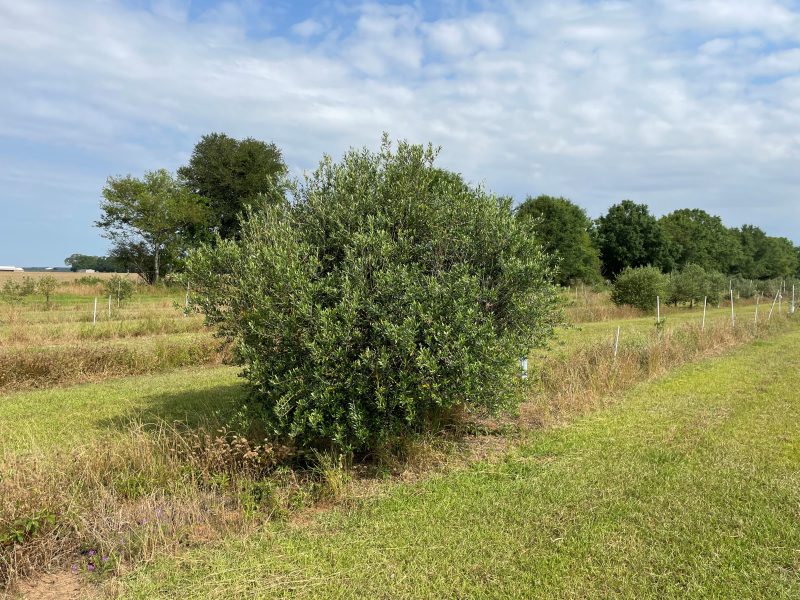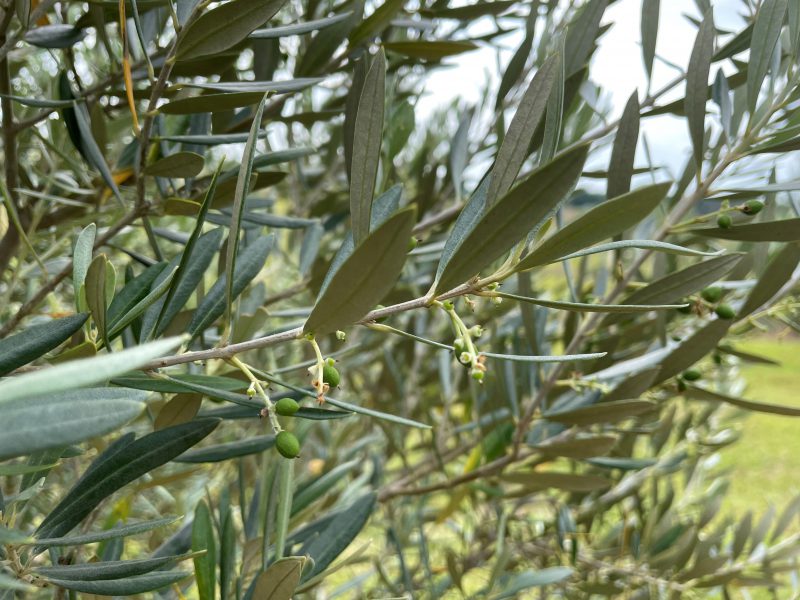The weather in Florida doesn’t resemble that of the Mediterranean. Our hot and humid climate is unpredictable. One day we might be dry and in the 70s. The next we might be hot and humid with afternoon showers. Of all things I could think of growing, olives definitely wouldn’t come to mind.

An olive tree Santa Rosa County, FL. Photo Credit: Matt Lollar, University of Florida/IFAS Extension – Santa Rosa County
–
History
Olive production dates back to 3000 B.C. The Semitic peoples in Syria grew olive trees and used olive oil to barter. Olive cultivation later moved northward to Turkey and south to Egypt. Around 1700 B.C. the Minoan people of North Africa brought olives to the Greeks and Romans. Olives didn’t make it into North America until the early 1700s when Jesuits set up missions in Mexico and California. Most of the places olives were initially carried are dry climates with consistent temperatures, but there are reports of olive groves near Daytona Beach dating back more than 300 years ago. Today there are an estimated 300 acres of olives in the state.
–
Site Selection
As you can imagine, proper site selection is key to having a productive grove. Young wood and new growth is killed when temperatures dip below 22°F, and whole trees can be killed if temperatures drop below 15°F. Olive trees require winter chill hours for good fruit set. These hours vary slightly from those required by other fruit trees such as peaches and apples. Olives prefer winter temperatures to be between 35° and 65°F. To help protect trees from freeze events and improve drainage, it is recommended that groves be planted on higher elevations relative to the surrounding acreage. An additional method to buffer temperatures is to plant the grove to the southeast of a water body. Even small ponds ranging from 1 to 10 acres have an effect on grove temperatures.

Young olive fruit. Photo Credit: Matt Lollar, University of Florida/IFAS Extension – Santa Rosa County
–
Planting and Maintenance
The traditional grove spacing is 30 feet between trees in a square pattern. However, some producers have opted to plant high density groves of up to 500 trees per acre. Increasing tree density to this amount allows for trees to begin producing sooner with higher yields per acre, but this doesn’t come without a cost. Of course this will make your initial investment bigger, but it also increases the potential for disease incidence. The closer trees are planted together, the less air circulation you will have in the grove. Lower air circulation around a tree increases the amount of time a tree stays wet after a rain or from dew and provides for an easier environment for diseases to thrive.
Another interesting thing about olive trees is they don’t like a lot of nitrogen. These are slow growing trees that don’t want to be pushed. To determine nutritional needs, it is recommended a tissue sample be taken late June when nutrient concentration is most stable. Samples should consist of 150-200 leaves from the middle of non-bearing shoots from the current season’s growth. For more information on leaf tissue testing and submission, please refer to the UF/IFAS Plant Tissue Test Form.
Although olive trees have been in Florida for quite some time, olive production in Florida is still in the trial stage. To see successful operations in the southeast, you may want to visit Green Gate Olive Grove in Marianna, FL or Georgia Olive Farms in Lakeland, FL. For more information on growing olives in Florida, the UF/IFAS publication Guide to Olive Tree Nutrition in Florida, which provides some good insight on tree care and maintenance.
- Benefits of Manure Fertilizers and Analysis - March 21, 2025
- Mushrooms – A Crop Worth Consideration for the Back Forty - October 4, 2024
- Hosting an On Farm Agritourism Event: Helpful Tips - February 16, 2024
